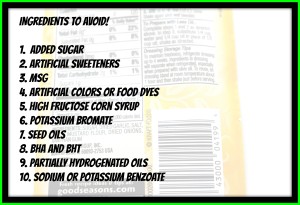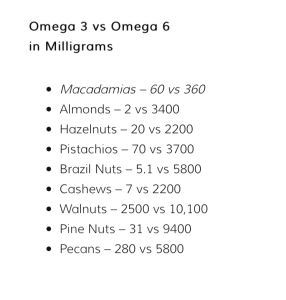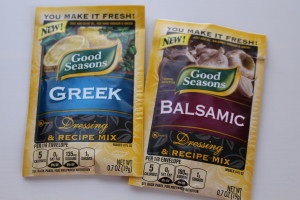 I fully admit I am a certified label reader. Sometimes I go to the store just to read the labels, well not really or at least I’m not admitting to that! It all stemmed from my search for a pre-made salad dressing that was made with just olive oil. Not olive oil plus canola/soy/sunflower oil but just plain olive oil! There is no such thing! I searched through every salad dressing at Wholefoods, Trader Joes and Stop-n-Shop. Although home made dressings usually taste better and are better for you sometimes I just don’t have the time or desire to squeeze a lemon and press garlic or cut up fresh herbs.
I fully admit I am a certified label reader. Sometimes I go to the store just to read the labels, well not really or at least I’m not admitting to that! It all stemmed from my search for a pre-made salad dressing that was made with just olive oil. Not olive oil plus canola/soy/sunflower oil but just plain olive oil! There is no such thing! I searched through every salad dressing at Wholefoods, Trader Joes and Stop-n-Shop. Although home made dressings usually taste better and are better for you sometimes I just don’t have the time or desire to squeeze a lemon and press garlic or cut up fresh herbs.
I try to avoid seed oils in my daily eating because an excess of Omega 6 (which is found in seed oils) is believed to be a major cause of inflammation in our bodies, which contributes to a host of health issues. Although we do need some Omega 6 oils, most of us get enough of them when we eat any processed food, nuts or when eating out. Our bodies need to have a similar ratio of Omega 3 and Omega 6 in order to avoid inflammation. However, Omega 3 is much tougher to find! None of us eats enough salmon or sardines (which are loaded with Omega 3’s) to have the right ratio, that is why it is essential to take a supplement. This is my favorite. Did you know Walnuts are one of the best sources of Omega-3 oils? but guess what else they contain? Even higher levels of Omega 6’s! So if you are eating a lot of nuts like me you really have to be careful that you are not getting Omega-6 everywhere else!
I recommend hazelnuts as a snack (not Nutella too much sugar!) and olive or avocado oil, coconut oil or butter/ghee for cooking and baking all which have much lower levels of Omega 6 oils than canola, sunflower, corn, soybean, peanut and cottonseed. Of the seed oils safflower has the lowest amount of omega-6 if you had to make a choice. (Sunflower, corn and cottonseed have the highest). When I snack I buy potato chips made with olive, avocado or coconut oil. Thrive Market and Vitacost both have a lot of chip options made with these oils.
Anyway back to the salad dressings…as I was reading every bottle I could, I came across the Good Seasons dressing pouches and I though ah-ha! I can use the seasoning pouch with olive oil! But of course I was disappointed to read that the first ingredient of the zesty italian one was sugar. It also contained maltodextrin (made from GMO corn), soy sauce which contains soy and wheat and natural flavors which is usually code word for MSG. Sigh. But I didn’t give up. I use to love the Good Seasons creamy chicken that you can make in the crock pot with the cream of mushroom soup (don’t get me started on the Campbell’s soup labels!) I moved onto a few more varietals of pouches and lo and behold I found 2 that met my label rules! (which by the way I will detail below) The Greek and Balsamic pouches did have sugar, 8 grams for the whole pouch (ok ok I’m not perfect) but the rest were just basic herb ingredients with no allergy or chemical offenders! YAY!
I guess my point is, if you take a few seconds to read labels:
A.) you can eliminate buying products with the biggest offenders and
B.) You can usually find a better alternative!
So what are some things we should look for? Here’s my simple go to list:
Sugar – It’s unrealistic to avoid all sugar in your diet but if you take a second to read the grams of sugar (5 grams =1 tsp) you can pick products with lower amounts. My rule of thumb is if it has over 5-10 grams per serving (make sure you look at the servings, a lot will trick you into thinking the whole product has 8 grams of sugar but the can has 4 servings and considering you’ll probably drink the whole thing thats 32 grams of sugar!) I don’t even consider it.
Biggest offenders: sauces (barbecue, pasta), granola bars, yogurt, breakfast cereals, bread/bagels, fruit juice, chinese take-out, candy, soda, baked goods
Artificial Sweeteners – Aspartame, Sucralose, Acesulfame Potassium, Saccharin. Not only do many experts believe that the research supporting these sugar substitutes is unreliable; many experts believe they can create severe symptoms in our bodies. Recent studies show that these chemically modified sweeteners can actually make your body crave sugar more since it is excepting glucose when something sweet is eaten, but it does not get it. This makes you much more susceptible to overeating!
Biggest offenders: yogurt, protein powder, protein bars, gum, beverages, diet foods
MSG – Unless you are prone to migraines or know that you react to it, a little MSG is not going to kill any of us. (I could write a whole article on why some people think it could but I’ll save that for later, here is a website if you are interested) I still eat Chinese food out on occasion. The problem I have with MSG is that in processed foods it is usually added to make a sub-standard crappy food-like product taste better than it really is. Your body thinks its getting this tasty, nutrient rich meal, and when it gets no nutrients at all it makes you feel hungrier because you body is starved for nutrition! Other code names for MSG: Hydrolized Protein, Autolyzed Yeast, Whey or Soy Protein, soy sauce extract. Sometimes means MSG: Natural flavors, carrageenan, seasonings
Biggest offenders: Chips, frozen dinners, cold cuts, gravies, ranch and other dressings, canned soups, flavored crackers
Food dyes – Here is a great article with sources on why to avoid them like the plague. This is all the colors plus carmel color! Interesting fact: Do you know they make clear gatorade but it’s very unpopular because our brains can’t register what flavor it will be without the coloring?
A large-scale British government study (published in 2007) in the UK medical journal Lancet) found that a variety of common food dyes, increased hyperactivity and decreased the attention spans of children. These additives were shown to adversely affect children with attention-deficit hyperactivity disorder (ADHD), along with children having no prior history of behavior problems. Read more
Biggest offenders: frosting, sports drinks, pickles, breakfast cereals, yogurt, mac and cheese, ice cream, candy, jams, condiments
High Fructose Corn Syrup – I wrote an article on why to avoid, find it here. Fructose cannot be used as energy by the cells of our body HFCS is 55% fructose. It has been shown to promote increased belly fat and insulin resistance—not to mention the long list of chronic diseases that result directly. The fructose in high-fructose corn syrup goes directly to the liver, where it converts to fat and can ultimately lead to heart disease. Agave syrup is very high in fructose also. I would avoid it.
Biggest offenders: Capri sun, soda, bread, breakfast cereals, condiments, pop-tarts, cough syrup, crackers, ice cream, sauces, Lunchables, canned soups, candy
Ingredients that are long, hard to pronounce and sound like a chemical! Now I admit chemicals are hard to sort through, take for example an ingredient, often an ugly-sounding chemical like propylene glycol, which is in anti-freeze and propylene glycol alginate, which is in beer and despite its name, is not even close to propylene glycol and is derived from kelp! I know there are naturally occurring toxins in fruits and vegetables but come on let’s use common sense, the more ingredients in a product with long names the more “un-natural” and preserved it is! Examples: Potassium bromate, Sodium benzoate, butylated hydroxyanisole (BHA), butylated hydroxytoluene (BHT).
Biggest offenders: Diet foods, commercially baked goods, crackers, margarine
I know it’s nearly impossible to eat whole foods everytime you eat, processed foods are convenient! But if you take a few minutes to become a “label reader” you can avoid a lot of sugar, dyes, chemicals and preservatives that may be affecting your health!


